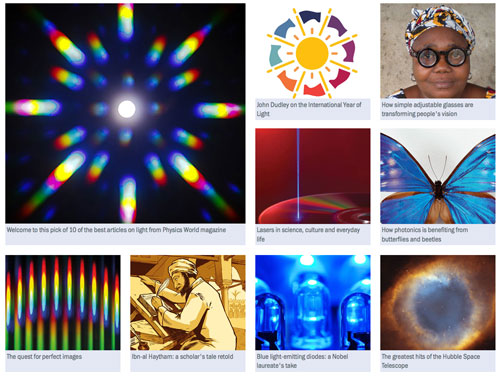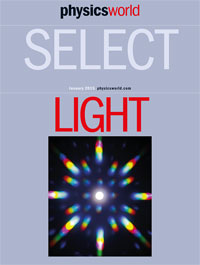
Celebrating IYL 2015 with a special free-to-read digital edition of Physics World.
By Matin Durrani
The International Year of Light (IYL 2015), which officially launches today at the headquarters of the UN Educational, Scientific and Cultural Organization (UNESCO) in Paris, is a brilliant initiative, but if you’re wondering how to find out more about the science and applications of light, then I’ve got the perfect place for you to start.
That’s because Physics World magazine is launching today a great, free-to-read digital edition containing 10 of our very best feature articles on the science and applications of light.
In the issue, which you can read via your desktop or on your smartphone or tablet using our new digital-magazine technology, you’ll be able to find out everything from the physics of rainbows and the science of “smart holograms” to how butterflies, beetles and other living creatures are inspiring photonic technologies that exploit the power of light.

There’s also a feature by Shuji Nakamura, who shared the 2014 Nobel Prize for Physics, about how he developed efficient blue light-emitting diodes, as well as an intriguing tale about the life of Ibn-al-Haytham – the talented Egyptian scholar who revolutionized our ideas of optics 1000 years ago. Plus, you can relive the best images taken by the most famous optical instrument of all – the Hubble Space Telescope.
As Editor of Physics World, it wasn’t easy for me to pick 10 articles from all the great stuff we’ve published on light over the years, but I think the collection we’ve created will have something for everyone.
Perhaps my favourite article, which really shows what IYL 2015 is all about, is a piece by Louise Mayor – Features Editor of Physics World – in which she describes how simple, low-cost adjustable spectacles, pioneered by physicist Josh Silver from the University of Oxford, are helping people with sight problems in the developing world. It’s a great example of how science and technology can work hand in hand to tackle global problems.
Read the edition either by downloading the Physics World app onto your tablet or smartphone, which is available for iOS and Android from the App Store and Google Play, or on your desktop. And with the IYL 2015 starting today, please do share the collection with any friends or colleagues you think might be interested.
Trackback: A global vision for vision | International Year of Light Blog
Trackback: Physics Viewpoint | Enjoy 10 of the best Physics World articles on light
Send me newsletter please
Trackback: Light stories on film | International Year of Light Blog
Trackback: Blog - physicsworld.com